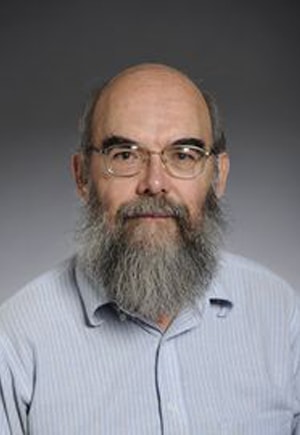Brian Quinn
Professor of Physics
Nuclear & Particle Physics
Quark Interaction Experiment
Wean Hall 8412
412-268-3523

Education & Professional Experience
Ph.D.: Massachusetts Institute of Technology (1984)
B.Sc.: McGill University (Canada), Physics (1978)
Professor of Physics, Carnegie Mellon University, 2001–
Indefinite Tenure, Carnegie Mellon University, 1996
Associate Professor, Carnegie Mellon University, 1994–2001
Assistant Professor, Carnegie Mellon University, 1988–94
Senior Research Physicist, Carnegie Mellon University, 1987–88
Post-doctoral Research: Carnegie Mellon University, 1984–87
Research Interests
Quark Interaction Physics generally concentrates on the middle ground between conventional nuclear physics and high energy particle physics, although the boundaries are not sharply defined. We are generally interested in problems in which the quark structure of hadrons (strongly interacting particles) is relevant. The energy range of interest doesn't usually lend itself to the simplifications of a perturbative treatment of quantum-chromodynamics. Rather, it allows us to explore a wealth of important topics, such as the structure of the hadrons themselves, which are intrinsically non-perturbative.
The Carnegie Mellon Quark Interaction group has participated in a rich variety of experiments over the past few years, using anti-protons to study annihilation on protons with the resulting creation of strange (and anti-strange) quarks; kaons and pions to study the weak decay of hypernuclei and to search for un-discovered states such as the H-dibaryon; and photons and electrons to probe strangeness production and the structure of the neutron. We have contributed to many aspects of these experiments: detectors, data-acquisition hardware, on-line acquisition programs and analysis. Carnegie Mellon graduate students have taken a leading role in the analysis and interpretation of the data from many of these experiments.
A high-current superconducting electron accelerator facility, Jefferson Laboratory (JLab), in Newport News, Virginia is an important center of Medium Energy research, and the venue for most of our experiments. I led our group's involvement in the G0 experiment which used the JLab beam to study the weak form-factors of the proton to probe the strangeness content of the nucleon. In the HAPPEX-III experiment, we recently completed a similar measurement with even greater precision at one kinematic point. The Compton polarimetry for that experiment was the thesis topic of my student, Megan Friend. An on-going set of parity-violation experiments will allow us to directly measure the neutron radius of the lead nucleus. A longer term experiment, MOLLER, will use parity violation to test the 'running' of the weak mixing angle, as a test of the standard model. Another high profile set of experiments will take advantage of the increased beam energy available after the JLab upgrade to measure the form factors of the nucleon, with great precision, at higher momentum transfer than has previously been possible. I am a spokesperson and have taken the lead on one of these, a measurement of the magnetic form factor of the neutron. An important piece of equipment for these measurements, the hadron calorimeter, was designed and prototyped here and is being built by CMU.
Selected Publications
A. Rakhman et al., A high-finesse Fabry–Perot cavity with a frequency-doubled green laser for precision Compton polarimetry at Jefferson Lab, Nucl. Instrum. Meth. Phys. Res. A 822, 82 (2016)
J. Benesch, G. B. Franklin, B. P. Quinn, K. D. Paschke, Simple modification of Compton polarimeter to redirect synchrotron radiation, Physical Review Special Topics - Accelerators and Beams 18, 112401 (2015)
D. Wang et al., Measurement of parity violation in electron–quark scattering, Nature 506, 67 (2014)
D.S. Parno et al., Comparison of modeled and measured performance of a GSO crystal as gamma detector, NIMA A 728, 92 (2013)
Z. Ahmed et al., New precision limit on the Strange vector form factors of the proton, Physical Review Letters 108, 102001 (2012)
S. Abrahamyan et al., Measurement of the neutron radius of 208Pb through Parity violation in electron scattering, Physical Review Letters 108, 112502 (2012)
M. Friend, G.B. Franklin, B. Quinn, An LED pulser for measuring photomultiplier linearity, Nuclear Instruments and Methods in Physics Research Section A: Accelerators, Spectrometers, Detectors and Associated Equipment 676, 66 (2012)
M. Friend et al., Upgraded photon calorimeter with integrating readout for the Hall A Compton polarimeter at Jefferson Lab, Nuclear Instruments and Methods in Physics Research Section A: Accelerators, Spectrometers, Detectors and Associated Equipment 676, 96 (2012)
S. Riordan et al., Measurements of the electric form factor of the neutron up to Q2=3.4 GeV2 using the reaction 3He(ee′n)pp, Physical Review Letters 105, 262302 (2010)
J. Lachniet et al., Precise measurement of the neutron magnetic form factor GMn in the few-GeV2 Region, Physical Review Letters 102, 192001 (2009)
J. Parker et al., Weak decays of Λ4He, Physical Review C 76, 035501 (2007)
K. Paschke et al., Experimental determination of the complete spin structure for p̅p→Λ̅Λ at pp̅ = 1.637 GeV/c, Physical Review C 74, 015206 (2006)
More Publications:
ORCID Researcher ID